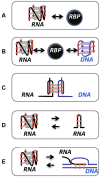RNA G-quadruplexes: emerging mechanisms in disease
- PMID: 28013268
- PMCID: PMC5389700
- DOI: 10.1093/nar/gkw1280
RNA G-quadruplexes: emerging mechanisms in disease
Abstract
RNA G-quadruplexes (G4s) are formed by G-rich RNA sequences in protein-coding (mRNA) and non-coding (ncRNA) transcripts that fold into a four-stranded conformation. Experimental studies and bioinformatic predictions support the view that these structures are involved in different cellular functions associated to both DNA processes (telomere elongation, recombination and transcription) and RNA post-transcriptional mechanisms (including pre-mRNA processing, mRNA turnover, targeting and translation). An increasing number of different diseases have been associated with the inappropriate regulation of RNA G4s exemplifying the potential importance of these structures on human health. Here, we review the different molecular mechanisms underlying the link between RNA G4s and human diseases by proposing several overlapping models of deregulation emerging from recent research, including (i) sequestration of RNA-binding proteins, (ii) aberrant expression or localization of RNA G4-binding proteins, (iii) repeat associated non-AUG (RAN) translation, (iv) mRNA translational blockade and (v) disabling of protein-RNA G4 complexes. This review also provides a comprehensive survey of the functional RNA G4 and their mechanisms of action. Finally, we highlight future directions for research aimed at improving our understanding on RNA G4-mediated regulatory mechanisms linked to diseases.
© The Author(s) 2016. Published by Oxford University Press on behalf of Nucleic Acids Research.
Figures




References
-
- Simone R., Fratta P., Neidle S., Parkinson G.N., Isaacs A.M.. G-quadruplexes: emerging roles in neurodegenerative diseases and the non-coding transcriptome. FEBS Lett. 2015; 589:1653–1668. - PubMed
Publication types
MeSH terms
Substances
LinkOut - more resources
Full Text Sources
Other Literature Sources
Molecular Biology Databases
Miscellaneous

